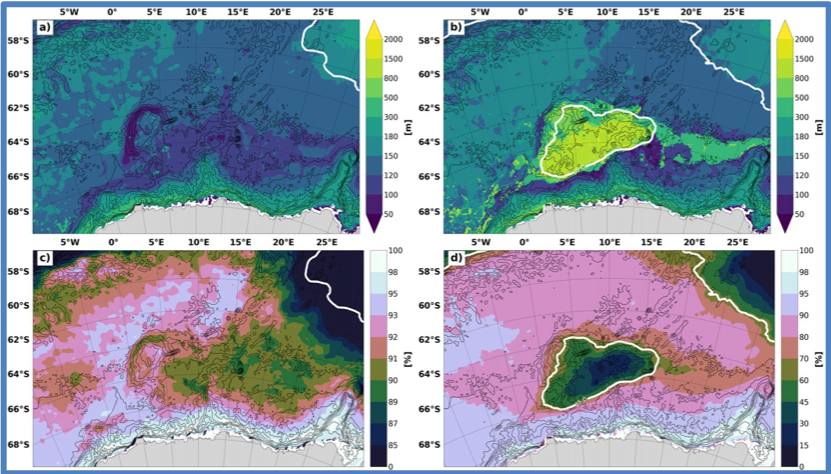Formation of Polynyas in a High Resolution ESM
An eddy-resolving Earth System Model helps scientists understand necessary conditions and triggers for the formation of Maud Rise polynyas.
The Science

Composite difference in mixed layer depth (a,b) and sea ice concentration (c,d) for years without (a,c) and with (b,d) Maud Rise polynyas. Black contours indicate bathymetry, while the white contour marks the 65% mean ice concentration level.
Open-ocean polynyas are regions of open water amidst the winter sea ice pack and are characterized by extreme air/sea exchange of heat and moisture. Their occurrence in nature, as well as their representation in ESMs, is very variable and episodic, potentially giving rise to significant model biases.
This work is among the first studies of Weddell Sea polynya formation in a global, fully-coupled Earth system model (ESM) with eddy-resolving resolution in the ocean, sea ice, and atmosphere.
Understanding the processes that precondition the Weddell Sea for the formation of polynyas, as well as the processes that trigger polynya formation, is critical for quantifying and reducing these biases. This study shows that an accurate representation of small-scale bathymetry, in particular around the Maud Rise seamount, is essential for generating Maud Rise and Weddell Sea polynyas.

Zonal evolution of upper ocean temperature (a) and salinity (b) anomalies around the Maud Rise region. Westward propagation of salinity anomalies into the polynya region can be seen in (b). The horizontal axis in the figure is longitude and the longitudinal range covers the Weddell Sea.
The Impact
This study emphasizes the impact that small-scale features can have on large-scale climate processes. It shows that low-resolution ocean models cannot represent processes that are essential for the formation of open-ocean polynyas, and hence ignore an important mode of air/sea heat exchange and Antarctic Bottom Water formation.
Summary
Research shows that resolving small-scale bathymetry and its non-linear interaction with the circulation is critical for faithfully representing polynyas in the Weddell Sea. This explains the general absence of open-ocean polynyas in low-resolution ESMs.
Publication
Contact: Milena Veneziani, Los Alamos National Laboratory
Funding: P. Kurtakoti and M. Veneziani acknowledge support of the U.S. Department of Energy (DOE)’s Office of Science (BER) through the E3SM project and the Center for Space and Earth Science (CSES) at the Los Alamos National Laboratory through a 2-yr graduate student project. Kurtakoti was also supported by the Department of Oceanography at Texas A&M University. A. Stössel acknowledges support from the CSES project for associated visits at LANL. W. Weijer acknowledges support from the DOE BER’s RGMA program as a contribution to the HiLAT project.


